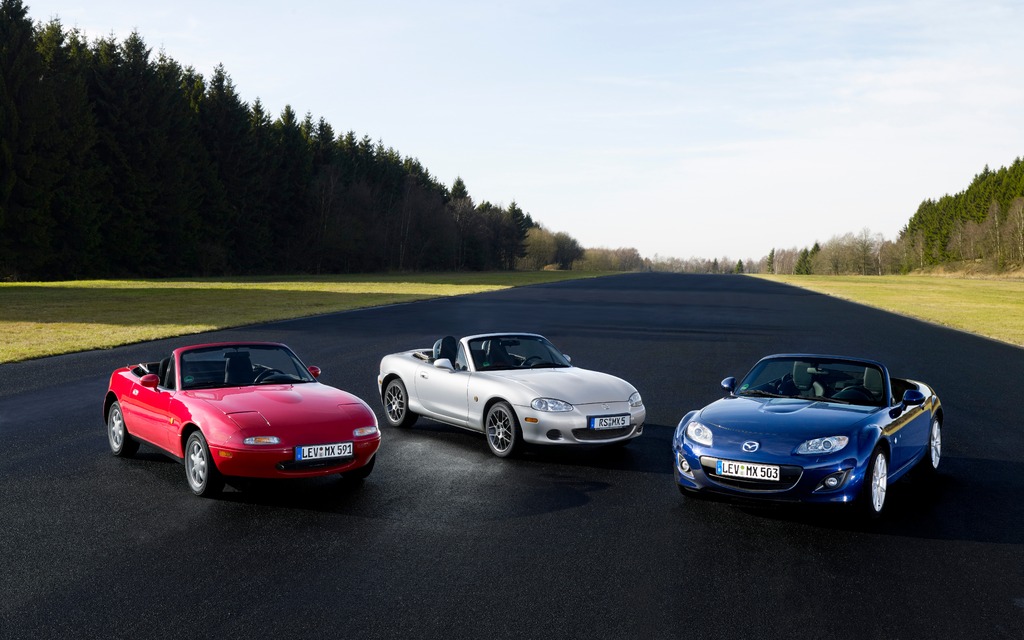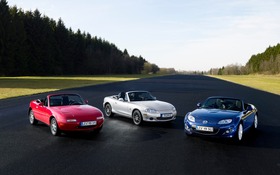Mazda MX-5: The First 25-Year Phase
Mazda decided that the New York Auto Show presented the perfect occasion to celebrate the MX-5’s twenty-fifth anniversary. After all, this legendary roadster has been dominating the still-exclusive small sports car market for quite some time. Wondering why they had a party in North America but not in Europe or Japan? The fact is that the MX-5 was built for our continent, which is also its biggest market.
For the festivities, more than a dozen old models representing three generations were brought in. This group included a few race cars and even a Miata coupe.
- Also: Mazda MX-5 25th Anniversary: They Sold Like Hotcakes
- Also: We Now Know What’s Under The Hood Of The Mazda MX-5
The occasion was also marked with the introduction of a commemorative model, of which only 200 units will be built: 100 in the U.S. and 100 in Canada. This time, Mazda Canada isn’t being treated like a backwater cousin. This special edition comes with a Red Mica retractable hard top and all the usual accessories for this vehicle category, including exclusively designed leather seats, a lacquered dashboard, unique wheels, special insignia, aluminum pedals, and so on. But the most important element is the use of perfectly balanced engine parts for optimum performance. It goes without saying that special shocks and 17-inch Bridgestone sport tires are also part of the package. This special model will sell for $40,925 (manual) or $42,125 (automatic).
10 years on the back-burner
The MX-5 may be celebrating 25 years on the market, but its gestation period sure was long. It all started back in 1979, when Mazda’s Director of Development Kenichi Yamamoto talked to American automobile journalist Bob Hall. At the end of the interview, Hall mentioned the possibility of creating a “light sport vehicle." All his life, Hall had driven British cars (MG, Lotus and Triumph) and, lamenting their poor quality, he decided to put his idea down onto paper. His first sketch caught the attention of Mazda engineers, but there were still a lot of skeptics to convince, and thus it took Yamamoto and Hall a long while to find allies.
It wasn’t until Yamamoto was promoted to President of Mazda Motor Corporation that the project finally received the support it needed to get off the ground. In 1984, a concept developed in California by Mark Jordan and Tsutomu “Tom” Matano won an internal design contest, coming ahead of two other contenders. In addition to its front-engine/rear-wheel drive configuration, this concept featured a number of characteristics that are still present on today’s MX-5.
Interestingly, they never planned on using the rotary engine that is so near and dear to Mazda’s heart. Company management determined that since the car was so small, light and reasonably priced, it should be equipped with parts from its large-scale production models. The brand’s engineers found the engine of their dreams— a 1.6-litre 4-cylinder—under the hood of the Mazda 323. They decided that the Mazda RX-7’s five-speed manual transmission would be the best option for directing the engine’s 115 horses to the rear wheels. They also chose a chassis with an independent suspension for each wheel, each equipped with disc brakes. In May 1987, a pre-series prototype was unveiled to a handful of automobile specialists—and they loved it! By April of the next year, there were no fewer than twelve MX-5/Miata prototypes. The American journalists who had the privilege of testing them that July urged Mazda to put the model into production. The rest is history, the history of a legend.
True to the original concept
The Mazda MX-5 went into production and was officially launched on February 9, 1989, at the Chicago Auto Show. Its curved lines were a radical departure from the competition’s designs at the time, like the Toyota MR2 and Fiat X1/9 (which would soon be discontinued). The rounded edges were somewhat disconcerting, but ultimately everyone loved the look. They even likened the vehicle’s silhouette to that of the first generation Lotus Elan. Since the Mazda roadster was extremely light, its relatively modest engine could still jet the vehicle from 0 to 100 km/h in 8.8 seconds. With its exceptional driving pleasure and road handling, combined with its very competitive price, the MX-5 became a worldwide success.
The second generation was unveiled at the 1997 Tokyo Auto Show, then in Europe a few months later at the 1998 Geneva Motor Show. This latest edition of the MX-5 kept the original model’s winning formula but enhanced the classic roadster design with even better handling and performance. The exterior design, however, was virtually unchanged.
Launched in 2005, the third generation of the MX-5 featured a longer wheelbase and track, as well as larger tires and more prominent wells for the 17-inch wheels. Even though it was bigger and better equipped than its predecessor, this new model weighed just 10 kilograms more. This was thanks in part to the fact that it was equipped with a new aluminum trunk hood and a greater proportion of high and ultra-high strength steel.
Barely a year later, Mazda responded to market demand by releasing a retractable hardtop version whose power roof took just 12 seconds to tuck away—and didn’t take up too much trunk space either.
Several improvements were made in the years that followed. But every new release remained true to the original concept, especially with regard to being light, easily manoeuvrable and fun to drive. And now, the new platform introduced at the New York Auto Show leads us to believe that this tradition will be preserved for years to come.












